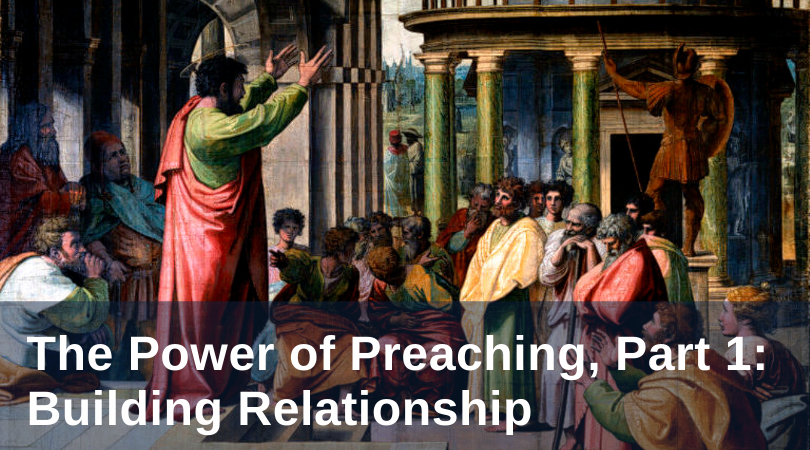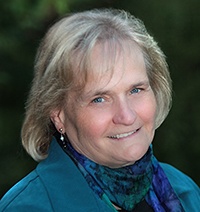
An image circulates on the news: a priest has taped pictures of his parishioners on his pews so that they are “there” when he is saying Mass. Presiding by oneself is empty. When there is no one to talk to, preaching goes flat. There is no energy—there is no head nod, no smile of response, no encouraging (or discouraging) body language from the “other.” Preachers may have once thought that they preached into a vacuum because they rarely got feedback. Now they know what it is like to preach into empty space. It is not the same. Why? Because preaching the Word of God is a two-way communication, a relationship of give and take between pulpit and pew.
I have coached about a hundred Catholic preachers—mostly priests, some deacons and lay preachers, and a few bishops. I am a homiletically-trained lay woman, a wife and a mother of five. I sit in the pew. I hear many homilies. I watch people sleep. I see people’s faith awakened. In the last six years, I have focused on helping “our guys” become more effective preachers for the people they love. What is different in this time of empty pews? Hopefully, we appreciate now more than ever before: the moment of the homily is a relational act of love between those who speak and those who listen.
Preaching matters. The people participate in the homiletic moment, pleading: “Is there a word from the Lord to help us in our struggles? Even if recorded online, can you rouse our faith, give us courage, and comfort our pain? Tell us more about what God is doing right now.” We need good preaching. In this hurting world, the Word and the word matters. Pious platitudes from the pulpit may once have been “good enough,” but they are no longer sufficient. As a Church, we need preaching that is effective, which “works” in leading us to encounter the living God.
But whose “problem” is it to bring about this effectiveness in preaching? I observe what I call “The Perception Gap” (see Connecting Pulpit and Pew). From those in the pew, I hear, “This is Father’s (or Deacon’s or Bishop’s) problem to say something meaningful to us.” From those in the pulpit, I hear, “The people are just not listening.” From those who are bishops, I hear, “The priests and deacons are not taking their preaching seriously enough.” All of that may (or may not) be true. But few take responsibility for their own role in the preaching event. And because of this perception gap, preaching is someone else’s problem. Thus we do not talk about it together.
As we eventually emerge from quarantine, will we as a Church go back to “the way things were”? Will we continue to have a gap between pulpit and pew? Or could we try things differently? Could there be a new-found solidarity in which we open the conversation about preaching with a new vision? Might priests listen to the needs of their parishioners because they know how much this living word means to them? Might bishops support their priests and deacons in their preaching efforts? Could parents learn to give helpful feedback so that their homilist connects with their teenaged son with credibility and fervor? Might preaching become an act of love within the solidarity of the saints on earth? Could we do that? Could we make that cultural change?
This article begins a five-part series on preaching. It is written for listeners. Preaching is a two-way communication. I have seen that comments from the pew make a difference to our homilists, both positively and negatively. Therefore, to improve Catholic preaching, we hearers can learn what “effectiveness in preaching” looks like and encourage it. We can become educated about homiletics in order to offer valuable feedback. This is a gift of love for our preachers.
This series is also written for homilists. I will speak of what I have seen and heard. I have seen preachers grow discouraged when people fall asleep while they are talking. I have seen “the guys” helped by parishioner response. I have also seen them led astray, for both pulpit and pew lack a clear understanding of what we are about in the preaching moment. Preachers have shared with me that even though they pour their energies into homilies week after week, they don’t see that their preaching “does anything.” They may wish for their preaching to make a difference in the faith lives of their people. They don’t know exactly how to help that to happen.
Today, we are in a season of desolation. This gives us time to ponder preaching. We could go back to the “same-old-same-old.” Or we could meditate and pray about how to “do” the relationship of preaching differently.
In the midst of this COVID-19 crisis, a priest friend emailed me, saying that he had had a transformation: he was about to write, “…in my daily Mass” in his homily, when he realized that, though he is alone, his celebration is not private, but “our Mass.”
In the same way, as integral to “our” Mass, the homily preached is not “my” homily and it is not “your” homily. It is “our” homily—the Word of God, living and active, for “our” people. We can be in solidarity in this moment. Together, we can break open the conversation about Catholic preaching, together, for the glory of God. Come and walk with us, O Holy Spirit!
Like what you read? Submit your email below to have our newest blogs delivered directly to your inbox each week.
Featured Image: Raphael (1483–1520), St. Paul Preaching in Athens (1515); public domain.


